Inside The New York Botanical Garden
Posted in NYBG in the News on July 7 2008, by Plant Talk
Blooming in the Bronx
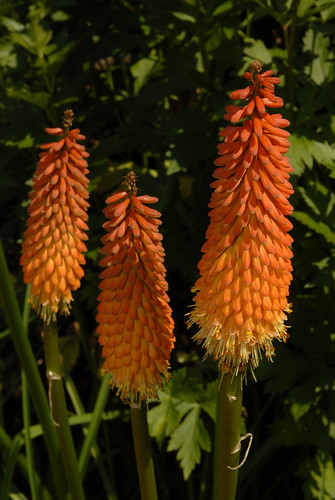 In the summer of 1977 the Bronx was literally burning. In the midst of a devastating blackout, New Yorkers were faced with looting, bankruptcy, municipal layoffs and the very real threat of the Son of Sam killer.
In the summer of 1977 the Bronx was literally burning. In the midst of a devastating blackout, New Yorkers were faced with looting, bankruptcy, municipal layoffs and the very real threat of the Son of Sam killer.
You’d have to be Rip Van Winkle to not notice that much has changed in the 31 years that have followed, but to some the rugged, urban stigma of the Bronx remains. No longer, says Associated Press Travel Editor Beth Harpaz. In her article, “The Bronx Is Blooming,” she celebrates the more than 7,000 acres of park land, and in particular, The New York Botanical Garden. As one of the many luscious “green spaces” in the borough, Harpaz credits the Garden and others as instrumental in revitalizing tourism in the Bronx.
The article is generating a lot of buzz and has been picked up by major outlets such as USAToday.com, CNN.com, AOL.com, NYPost.com, AMNY.com, Newsday.com, CBSNews.com, the Poughkeepsie Journal.com, and more.
Also in the News, Michael J. Balick, Vice President for Botanical Science at the Garden was quoted in a New York Times article about picking your own berries this summer. He doesn’t exactly give a ringing endorsement to the flora found along the Bronx River Parkway, but you can learn more about what not to eat in a book he co-authored, “Handbook of Poisonous and Injurious Plants.” And, if you want to pick some of your own berries this summer, here are a few tips to get you started.
Posted in Programs and Events on July 3 2008, by Plant Talk
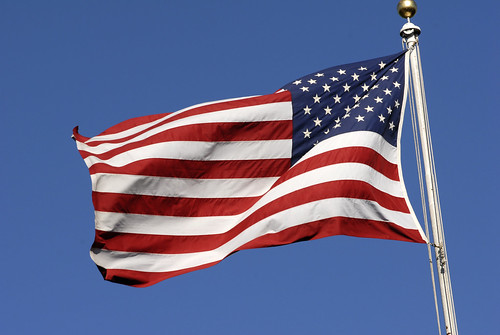 Happy Fourth of July!
Happy Fourth of July!
The weather forecasters have good things in store for us this holiday weekend, so why not spend our nation’s birthday at one of the best getaways NYC has to offer? If you’re not scarfing down hot dogs and “ooh” and “ahh”-ing at the fireworks display, there’s plenty of stuff to keep you busy at the Garden all weekend long.
Guided tours, screenings of The Art of Henry Moore, edible herbs and flowers, and much more are on tap.
Saturday, July 5, schedule
Sunday, July 6, schedule
Posted in Darwin's Garden, Exhibitions, People on July 3 2008, by Plant Talk
Jane Dorfman is Reference Librarian/Exhibitions Coordinator in the LuEsther T. Mertz Library.
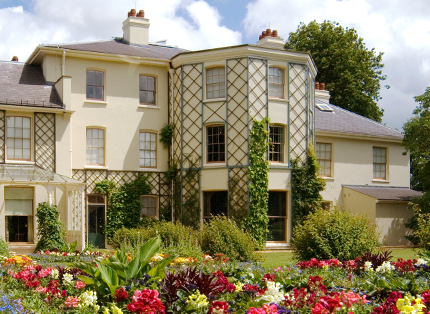 |
| © English Heritage Photo Library |
I just returned from a short visit to the United Kingdom where a colleague from the Royal Horticultural Society Lindley Library arranged for a private tour of Down House, the home of Charles Darwin. He lived there with his family for the last 40 years of his life, experimenting with plants.
The tour of the house and garden was led by author and conservationist Randal Keynes, a great, great grandson of Charles Darwin. Erudite and charming, Mr. Keynes offered insights and details about the life and work of his extraordinary relative that enlivened and inspired the experience.
Come and be inspired, as well, by the work of Charles Darwin in the Mertz Library’s Rondina Gallery exhibit, Darwin’s Garden: An Evolutionary Adventure, which continues until July 20.
Posted in Programs and Events on July 2 2008, by Kate
Kate Murphy, a junior at Fordham University, and Genna Federico, a senior at St. John’s University, are interns working in the Communications Department this summer.

The Farmers Market is in full swing at NYBG. Every Wednesday through October 29, from 10 a.m.–3 p.m., regional venders sell everything from fresh produce to fresh bread and other baked goods. So, naturally, we decided to check it out!
First we tried some delicious sugar snap peas, fresh from Migliorelli Farms of Tivoli, NY. They were crisp and sweet and would make for a tasty side dish for a summertime meal.
Joseph Bases, from the Little Bake Shop of Valley Cottage, NY, gave us suggestions as to which of their many all-natural and organic pies we should try first. While the apple pie is everyone’s favorite staple, Bases suggests the peach blueberry pie for a summertime treat. Bases explained that he loves selling here, calling it “a day at the park.”
The helpful people from Gajeski Farms of Riverhead, Long Island, helped us navigate through their overwhelming selection of fresh fruits and vegetables. They suggested we try the sweet corn—it’s the first of the season!
Bread Alone, from Boiceville, NY, had a wide selection of baked goods and breads. Suggestions include the “Whole Grain Health” bread, which includes five whole grains, honey, and sunflower seeds, and the mild “Whole Wheat Sourdough” bread. Both are organic.
We noticed a few people walking around munching on cherries, and we found the source at the Mead Orchards booth. These fresh fruits and veggies were brought to NYBG also from Tivoli, NY, and everyone seemed to be raving about the tart cherries. When one woman asked how they should be eaten, the vender simply replied “One after another!”
It can’t get much better than eating some healthy, natural treats and supporting local farms. So come out to NYBG’s Farmers Market.
Posted in Gardening Tips on July 1 2008, by Sonia Uyterhoeven
Slugging It Out
 Sonia Uyterhoeven is Gardener for Public Education at The New York Botanical Garden.
Sonia Uyterhoeven is Gardener for Public Education at The New York Botanical Garden.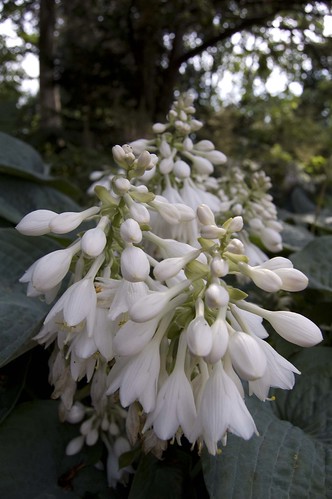
I love hostas. Since they are so overused they have the potential for being an exceptionally boring plant, yet they are saved by the fact that they excel in shade, are wonderful foliage plants, and come in so many different shades, textures, and sizes.
The only problem is that by midsummer they are full of holes. Hostas are a staple of the slug’s diet, so often a little extra care from the gardener is needed to keep them from an “unholy” state.
Commercial products that prevent slugs from devouring hostas contain iron phosphate and are safe and easy to use. There are also many home remedies. The classic one is to set out a bowl of beer, leading to the slugs drowning to their delight. Rumor has it that slugs will travel up to two miles for a good drink.
Another simple alternative is to surround your hostas with a small barrier of used coffee grounds: caffeine kills slugs. You can also surround your hostas with diatomaceous earth or trap them with grapefruit rinds (you are then left to clean up the mess). Hostas that have thick, puckered leaves are less susceptible to attack.
Posted in NYBG in the News on June 30 2008, by Plant Talk
People Are Talking About…
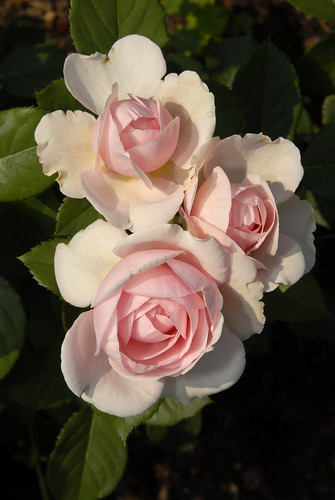 June is renowned for roses, and plenty of media took note of the magnificent Peggy Rockefeller Rose Garden. But beyond the roses, which will be in bloom through the fall, people across the Web were talking about The New York Botanical Garden.
June is renowned for roses, and plenty of media took note of the magnificent Peggy Rockefeller Rose Garden. But beyond the roses, which will be in bloom through the fall, people across the Web were talking about The New York Botanical Garden.
The The New York Sun featured the Peggy Rockefeller Rose Garden with a front page photo. Don’t fret if you missed it; you can still read the accompanying story and browse a cool photo slideshow of a gorgeous afternoon in the Rose Garden.
While there is nothing more glamorous than a beautiful rose in full bloom, the people at Glam.com took notice that some of the products at NYBG Shop in the Garden are pretty snazzy in their own right. Reviewer Jennifer Kopf had plenty of nice things to say not just about the Rose Garden but also about the wide selection of terra-cotta pots, planters, and other garden-related items.
The New York Academy of Sciences Web site, Science & the City, listed the Ruth Rea Howell Family Garden’s cooking demonstration Herbal Tea and Snack Sampling. Why not take their advice and come snack on savory eats and sip herbal tea, all from plants grown at the Family Garden, during July from 1 to 5:30 p.m.
Blogger Marie from Bethlehem, PA, documented her recent trip to NYBG with a rundown of her favorite spots in the Garden, complete with full-color pictures.
Posted in Programs and Events on June 27 2008, by Plant Talk
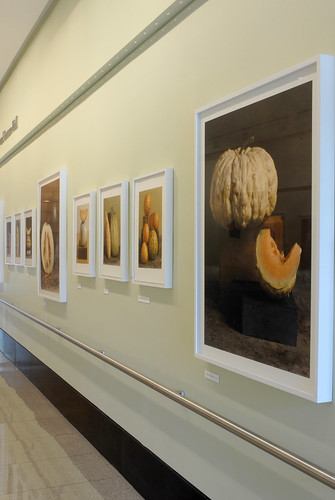 Ah, when to the heart of man
Ah, when to the heart of man
Was it ever less than a treason
To go with the drift of things,
To yield with a grace to reason,
And bow and accept the end
Of a love or a season?
— Robert Frost, “Reluctance”
(final stanza)
Nothing lasts forever, and spring has given way to summer here at the Garden. We tried to stop it, but there are just some things that have to come to an end. Unfortunately, that holds true for some of the programming at the Garden as well. This weekend is the last time you can…
- Go on a guided bird walk (until the fall)
- Make your way to the strawberry patch in the Ruth Rea Howell Family Garden and create your very own berry botanical button and sample a strawberry smoothie (until next year)
- Conduct a Charles Darwin-like experiment to explore how seeds travel by water, create herbarium specimens, or explore an interactive Tree of Life in the Everett Children’s Adventure Garden (closing)
- View the photography exhibit A Passionate Grower: Heirloom Melons and Squashes from the Gardens of Amy Goldman — An Exhibition of Photographs by Victor Schrager (closing)
But that’s far from all the goings on at the Garden this weekend, check out:
Posted in Programs and Events, Science on June 26 2008, by Plant Talk
 How would you like to help us collect information that can lead to a better understanding of the impact of climate change on plants?
How would you like to help us collect information that can lead to a better understanding of the impact of climate change on plants?
The New York Botanical Garden is looking for volunteers who are interested in being trained by experts on various aspects of plant biology and ecology, data collection and input, and then gathering facts about the Garden’s own 50-acre, old-growth Forest, the last remnant of the forest system that once covered much of New York City. The time commitment is one to two hours per week in the spring and fall for one to two years. The program is in partnership with the Northeast Regional Phenology Network and Cool Air–Clean Planet, organizations whose renowned expertise in phenology and climate change will contribute to this dynamic effort.
If you are interested in helping out, come to the open house on Friday, August 22, from 5 to 7 p.m. By becoming a Citizen Scientist, you will reap the benefits of being a Garden volunteer, including free admission, free parking, guest passes, and discounts on classes and at Shop in the Garden. For more information, contact Jackie Martinez, Director of Volunteer Services, 718.817.8564, or email volunteer@nybg.org
Posted in NYBG in the News on June 24 2008, by Plant Talk
Summer Sculpture Spectacular
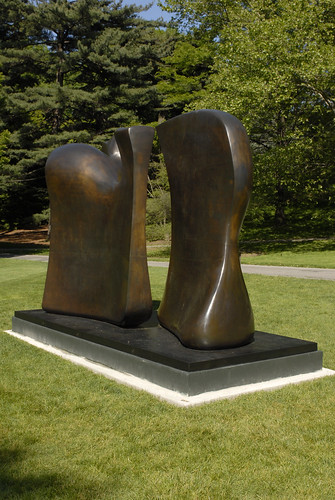 Summer is descending on New York City, and that means it’s time to dust off those shorts and sandals. Right now the weather couldn’t be better, which is why it’s no surprise that NYBG’s current exhibition, Moore in America, has been noticed as one of the best outdoor sculpture exhibits in the city!
Summer is descending on New York City, and that means it’s time to dust off those shorts and sandals. Right now the weather couldn’t be better, which is why it’s no surprise that NYBG’s current exhibition, Moore in America, has been noticed as one of the best outdoor sculpture exhibits in the city!
Artinfo.com gives a nice rundown of the top five NYC oudoor sculpture exhibits this summer. Moore in America is compared favorably to the other shows in the city, outranking works by Jeff Koons, Richard Deacon, and Tom Otterness.
While the art scene can seem a little stuffy and exclusive to the uninitiated, BLACK20 News breaks down Moore in America for the average Joe. According to its site, the weather commands you to come see the show: “Get a taste of culture amid your typically brain-numbing summer fare. Nature demands it!!!” How can you argue with that?
Some of the Garden’s fans in Germany and France will get the chance to see a new documentary, The Gardens of New York. European filmmaker Veronika Hofer shot portions of the doc at the Garden and other locations across New York. Hopefully we’ll get an Engligh-language version soon.
Channel Thirteen/WNET continues to air its captivating episode of New York Voices about Darwin’s Garden. Those of you who woke up too late to catch last Saturday’s 7 a.m. airing can always view the entire episode on-line. If that’s not enough, the program has an entire NYBG-devoted web page with interviews of people such as Dr. Dennis Stevenson and a tour of the Pfizer research lab.
And just because he’s so cute, here’s a preview of WNET’s piece on Snowflake, the white gorilla. Try and resist his cuteness!
Posted in Gardening Tips on June 24 2008, by Sonia Uyterhoeven
Rose Companions
 Sonia Uyterhoeven is Gardener for Public Education at The New York Botanical Garden.
Sonia Uyterhoeven is Gardener for Public Education at The New York Botanical Garden.
 Everyone needs a good friend, and roses are no exception. As the growing season progresses, the tops of roses remain nice and lush, but the bottom can start to look leggy and sparse. Hiding their bare legs with a companion plant is a simple remedy.
Everyone needs a good friend, and roses are no exception. As the growing season progresses, the tops of roses remain nice and lush, but the bottom can start to look leggy and sparse. Hiding their bare legs with a companion plant is a simple remedy.
The wispy flowers and foliage of ornamental sage (Salvia), Russian sage (Perovskia), and catmint (Nepeta) are three good options. Annuals to think about are cherry pie (Heliotrope), Lantana (Lantana), or summer snapdragons (Angelonia).
Aside from aesthetic qualities, some companions are said to protect other plants or enhance their growth. Members of the onion family are rumored to ward off aphids and help prevent black spots, so plant your alliums around your roses. Scented geraniums (Pelargonium), rue (Ruta), and feverfew (Tanacetum) are reported to repel Japanese beetles.
Remember that companions not only need to look good together, but also require compatible growing conditions. Roses perform best in full sun and in soil with good drainage; their companions should do the same.
 In the summer of 1977 the Bronx was literally burning. In the midst of a devastating blackout, New Yorkers were faced with looting, bankruptcy, municipal layoffs and the very real threat of the Son of Sam killer.
In the summer of 1977 the Bronx was literally burning. In the midst of a devastating blackout, New Yorkers were faced with looting, bankruptcy, municipal layoffs and the very real threat of the Son of Sam killer.









